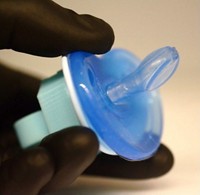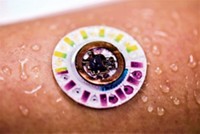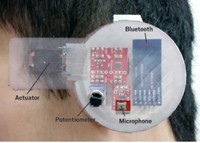Advertisement
Grab your lab coat. Let's get started
Welcome!
Welcome!
Create an account below to get 6 C&EN articles per month, receive newsletters and more - all free.
It seems this is your first time logging in online. Please enter the following information to continue.
As an ACS member you automatically get access to this site. All we need is few more details to create your reading experience.
Not you? Sign in with a different account.
Not you? Sign in with a different account.
ERROR 1
ERROR 1
ERROR 2
ERROR 2
ERROR 2
ERROR 2
ERROR 2
Password and Confirm password must match.
If you have an ACS member number, please enter it here so we can link this account to your membership. (optional)
ERROR 2
ACS values your privacy. By submitting your information, you are gaining access to C&EN and subscribing to our weekly newsletter. We use the information you provide to make your reading experience better, and we will never sell your data to third party members.
Analytical Chemistry
Wearable Device Analyzes Sweat To Monitor User’s Health
Biomarkers: New head-, wrist-, and armbands go beyond Fitbits by detecting levels of glucose, lactate, sodium, and potassium in sweat
by Stu Borman
January 28, 2016
| A version of this story appeared in
Volume 94, Issue 5

“Never let them see you sweat,” a slogan from 1980s deodorant commercials, is an admonition volunteers in a recent research study happily agreed to ignore. The subjects worked up a good sweat while exercising to test newly developed wristbands, armbands, and headbands that monitor skin temperature and compounds found in sweat.
Fitbit and other popular wearable fitness trackers can measure walking distances and heart rates. But the new system goes far beyond that to analyze multiple aspects of a person’s health through sweat compounds, possibly creating alerts for conditions such as dehydration, muscle cramps, or even improper glucose metabolism caused by diabetes.
The new wireless devices were developed by electrical engineering professor Ali Javey of the University of California, Berkeley, and coworkers (Nature 2016, DOI: 10.1038/nature16521) and tested on 26 men and women, who wore the sensors while either pedaling stationary bikes indoors or running outdoors. Wearable sweat-analysis systems have been developed before but could monitor only a single analyte at a time or lacked onboard circuitry and calibration mechanisms needed to accurately analyze the data to provide insight into a user’s physiological state, the researchers say.
“The multimodal operation and full wireless capabilities represent particularly notable features,” comments bioanalytical device specialist John A. Rogers of the University of Illinois, Urbana-Champaign. He says potential applications include health care diagnostics that can monitor user health continuously and in real time.
The device combines a sensor array and circuit board on a flexible polyethylene terephthalate substrate. The array has sensors that detect two metabolites, glucose and lactate, by monitoring current generated when immobilized enzymes oxidize the compounds; ion-selective electrodes that detect sodium and potassium ions; and a resistance-based skin temperature sensor. The device calibrates and calculates the concentrations and broadcasts the data wirelessly to a smartphone or computer.
The skin temperature readings are used to calibrate the sensors, which generate temperature-dependent responses. Sweat glucose levels correlate with blood glucose levels, which patients with diabetes must monitor regularly. Lactate concentrations in sweat can serve as a marker of restricted blood flow to tissues. Sodium and potassium levels in sweat can indicate conditions such as muscle cramps, dehydration, electrolyte imbalance, and cystic fibrosis.
The system could be extended to other analytes. In a published Nature commentary, electrical engineer Jason Heikenfeld of the University of Cincinnati notes that “small-molecule drugs and their metabolites come out in sweat, so this body fluid might one day be used to monitor the amount of active drug in a patient’s blood.”
Javey’s team has filed a patent for the device. He thinks it would cost some tens of dollars to manufacture.







Join the conversation
Contact the reporter
Submit a Letter to the Editor for publication
Engage with us on Twitter